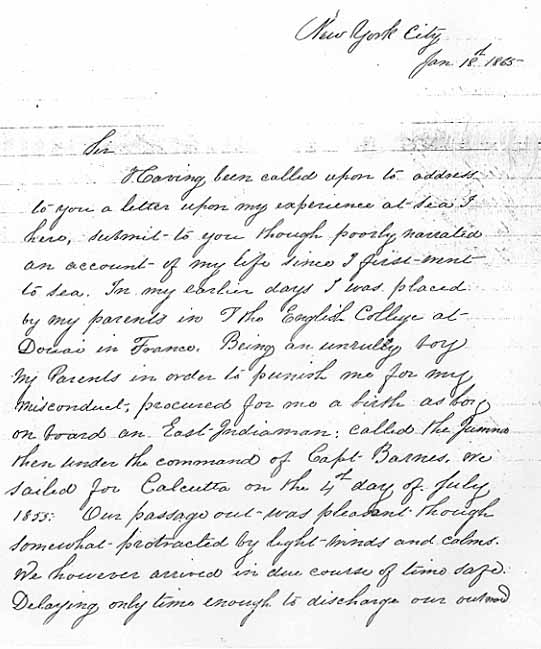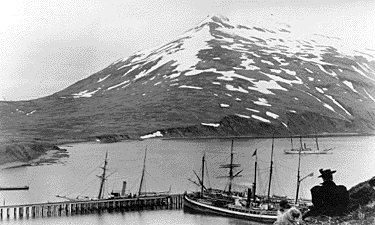
Racial Identity and the Case of Captain Michael Healy, USRCS, Part 2
Fall 1997, Vol. 29, No. 3
By James M. O'Toole
© 1997 by James M. O'Toole
The younger Michael Healy took a different course; he chose, in a sense, to wear a different kind of uniform from the religious garb of his siblings. Born in 1839, he followed the well-worn path of his older brothers from Georgia to Holy Cross College. He was, however, an independent and often difficult lad, and he kept running away into the surrounding countryside, never getting very far. He was also sometimes subjected to the jibes of his classmates. Though he was very fair in complexion, students at the school who had known the other members of the family, especially the dark-skinned Sherwood, often taunted Michael about his mixed race background. "Remarks are sometimes passed which wound," his brother Patrick, back at the college for a time as a teacher, told a friend. "You know to what I refer," he added, unwilling to commit the family's racial secret to paper. "The anxiety of mind caused by these is very intense."(10) Young Michael's own reactions were not recorded, but these experiences, coming when he was just a teenager, seemed to breed in him an aggressive personality, one that left him hot tempered and eager to prove himself before anyone could make unwelcome "remarks."
By the beginning of the 1854 school year, other academic arrangements were necessary for Michael. He was "a source of great anxiety to us," Patrick reported, and "his conduct hitherto gives us no reason to hope for a change." James Healy, acting now in the role of substitute parent, was just then completing his seminary training in Paris, and he hit on the idea of bringing Michael to France and enrolling him in the famous seminary at Douai—but not "to make a priest of him," he said, realizing that some things were out of the question. Rather, this move would "give him a chance to redeem his lost time and character." Running away from the French school was more difficult, but it also opened up more exotic possibilities, and Michael rose to them. In the summer of 1855, he fled to England, and there he felt the pull of the sea, taking a berth as a cabin boy on a merchant ship bound for the Far East. In later life he would carefully revise his biography for these years, saying that this had all been arranged by his parents—they had been dead for five years by then—"in order to punish me for my misconduct."(11) In fact, the idea had been his alone, and it set him off toward his true calling.
If we can believe his own later account, he spent the next several years wandering the world: India, China, Africa, the Caribbean and the Mediterranean, England, and America. He had a real aptitude for the work, and he rose through the lower ranks to first mate. The life was "comparatively easy, having never suffered actual shipwreck," though lesser disasters were met and surmounted. By the time of the Civil War, he was in Boston with much of the rest of the family, and he was filled with a "definite determination" to continue his seaborne life in the Revenue Cutter Service. Part of the Treasury Department, the service was a civilian agency that supervised the coastal trade, pursued and arrested smugglers, enforced treaties regulating the international fisheries, and provided emergency assistance on the high seas. Enlisting in September 1863, Michael Healy made his formal application for a commission a year later. He was just twenty-five, but his experience was impressive: "have been to sea for nine years, and have been three times second officer and once first officer of a brig." He had not done as well as he had hoped on the written examination, but captains under whom he had served attested to his ability and promise.(12)
He was also able to marshal some important political endorsements. By now, his brother James, who had hoped for redemption of his character a decade before, was clearly on his side. More to the point, he was also in a position to be of practical help in securing an officer's rank. James had become the chancellor of the Catholic diocese in Massachusetts and secretary to its bishop; in fact, during much of the Civil War, while the bishop himself was in Europe in a vain attempt to recover his health, James Healy was the de facto leader of Boston's growing Catholic community. That role put him in regular contact with some very important people who were now encouraged to support Michael Healy's cause. John A. Andrew, the staunchly pro-Union governor of Massachusetts, wrote to Washington, urging swift and favorable action on the appointment. "I do not know [Michael] Healy myself," he explained to a Republican ally in the capital, "but I am well acquainted with his brother, Revd. James A. Healy, the Secretary to the Bishop of this Diocese; and if one can argue from the qualities of a clergyman to those of a sailor, and the two brothers are alike, I should say that you would have few brighter and more capable young officers in your Revenue Marine than Healy." Other church contacts paid off as well. The bishop of Portland, Maine, who had almost certainly never met the candidate, sent a recommendation directly to the Secretary of the Treasury, William Pitt Fessenden, who happily enough was from Maine. All the lobbying paid off, and by January 1865 Michael Healy's appointment to the rank of third lieutenant came through.(13)
He had found a career in which his racial heritage, were it known, might not have been quite the disability that it was elsewhere. Work on the sea offered unusual opportunities to African Americans throughout the nineteenth century: aboard ship, raw ability and level-headedness in a crisis simply counted for more than skin color. Moreover, during the war, the U.S. Navy had recruited more free blacks and former slaves than the reluctant army, though it drew the line at commissioning them as officers.(14) Against this background, Michael Healy was less likely to suffer disadvantage from a society that, in spite of his physical appearance, was still prepared to define him as black because of his mother's racial classification. He was unwilling to test that possibility, however, for he and his family had come to identify themselves insofar as possible with the white community. Some of those endorsing the young officer's case knew his mixed racial background—others surely did not—but none of them ever mentioned it, then or later. Like his brothers and sisters, he defined his own racial status as white, and his decidedly light skin permitted him to do so. The taunts he had endured at school had only reinforced his intention to put behind him any suggestion of blackness, and his new career could insulate him from similar insults in the future, just as his siblings' careers in the Catholic Church insulated them. His own embrace of whiteness was also confirmed by his marriage to Mary Jane Roach, the daughter of Irish immigrants to Boston, in January 1865, just one week after his Revenue Cutter Service appointment became official.(15) For the remainder of his career, all those who met him—fellow officers, crew, and others—simply assumed that he was white.
Healy was a capable officer, and his progress up the service ladder was steady. His first assignments were on the east coast, but by the middle of the 1870s, he was posted to California for duty in the Arctic fleet. The United States had only recently purchased Alaska, and while most of the government settled into a pattern of ignoring the territory, the Revenue Service took it upon itself to establish a presence there in the interest of fundamental law and order. Several cutters were based in San Francisco and Oakland, but every spring they would make their way up the coast to Washington State before striking out across the open sea for the Aleutians. From headquarters on Unalaska Island, they would spend the summer cruising the Bering Sea and Straits, putting in at various places along the Alaskan coast and at the Pribilof and other small islands. These were the prime seal rookeries, and the Revenue Service waged a constant and often unsuccessful battle against illegal seal hunting. The ships would then work their way around the top of Alaska, heading as far east as Point Barrow. These waters had become the principal hunting grounds for the American whaling fleet, which was enjoying its last few years of prosperity. The work was dangerous and unpredictable, with the ice pack never more than ten miles offshore. As the summer advanced and the ice began to move in, cutters and whalers alike would break south, but not always fast enough. Officers like Mike Healy helped pull many ships out of the ice, rescued the stranded survivors, and more than once brought back the frozen bodies of the less fortunate. With only minor blotches on his record, Healy was commissioned a captain in March 1883.(16)

